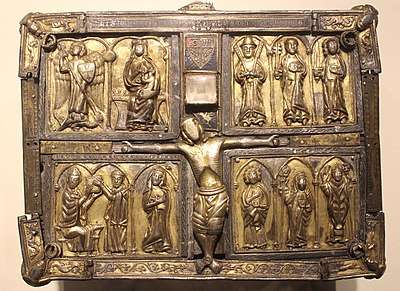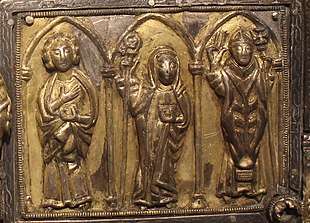Domhnach Airgid
The Domhnach Airgid (English: Sliver Church) is an 8th-century northern Irish metalwork and wooden cumdach (book shrine), since 1847 in the National Museum of Ireland (Kildare Street site) in Dublin.[1] It is traditionally associated with Saint Patrick, who was thought to have had it in his possession at one point. The shrine was built in three main phases; in the late 8th and 9th centuries, and in the 14th and 15th centuries.[2] It is thus considered a mixture of the early Insular art and later International Gothic styles.

A redesign c. 1350 added most of the extant frontpiece metalwork and relief plaques. Today the Domhnach Airgid comprises two separate main elements: an outer casket or box and an wooden box or container for relics; originally it held fragments of a 6th-9th century manuscript. The oblong box is heavily inscribed with lettering which along its outer borders, and is covered by silver and bronze panels which contain fragments of a vellum manuscript of the Gospels written in Latin.[3] Thirty-nine pages of the manuscript survive,[1] each about nine inches in height.[4]
The Domhnach Airgid is one of the few extant Irish shrines thought to have held non Irish relics.[5] Based on the inscriptions on the frontpiece, it is one of the earliest surviving depictions of apostles with their attributes and Instruments of the Passion.[2] It was placed number 48 in the semi-official list of A History of Ireland in 100 Objects.[6]
Description

Due to its age, the Domhnach Airgid is in poor condition. Areas of the gilding contain accumulations of dirt, and any colourisation has long since faded, giving it its current dark appearance of mostly brown and black hues.[4]
The shrine was originally built in the 8th century, but little is visible from before a major reworking around 1350 by the abbot of Clones. What does remain from the original consists of tinned copper alloy plates positioned on two sides and on the top of the shrine, which are thought to have given it its name (Silver Church). These plates are decorated with cut in interlace designs, which have been dated to the late eight or early ninth centuries.[2]
A fully three-dimensional figure of Christ crucified is at the centre of the main face, with relief plaques of saints and the Virgin and Child, and other scenes on the sides which combine principal figures in relief and others in engraving.[7] The style is rather more sophisticated than in some 14th century reworkings, with elegant running animals or grotesques placed on small mounts at the corners.[7] A dove, representing the Holy Spirit and decorated with a crystal, hovers above Christ's head.[8]

There eleven smaller sized figures around Jesus, all ornately and delicately carved. They include a grouping of three apostles, probably James, Peter and Paul, the panel showing the Archangel Michael and the Virgin and Child, a panel with a grouping of Saint Colmcille, St. Brigid and Patrick, while with the saint at the lower right is thought to represent of Patrick presenting a cumdach to St. Macartan.[9]
The casket was built to hold a number of relics, by legend associated with Patrick. In this tradition, the shrine was thought to have been in his possession and was sanctified by him[4] before he gave it to St. Macartan. The shrine thus became a significant and prized object that was widely venerated.[10]
It consists of three covers, with the center one being made of wood, probably from yew. Another is made from copper, plated with silver. The outer cover, pictured above, is of the highest quality, and lined with silver and decorated by gilding.[11]
History
And the Saint then left Bishop Mac Carthainn there, at Clogher,
and bestowed the Domhnach Airgid upon him,
which had been given to Patrick from heaven,
when he was on the sea, coming to Erin.
Matthew Arnold, "Celtic Literature", 1891[12]
The case was significantly remodeled around 1350 (a dating established by George Petrie) by the goldsmith John O’Bardan, during work commissioned by John O’Carbri, abbot of Clones. O’Bardan, whose signature appears on the object and is known to have lived in Drogheda, modernised the appearance of the shrine in the contemporary International Gothic style,[10][13] and added the figures of Jesus and the saints.[10] O’Carbri likely had political motivations for commissioning the redesign in the context of the Anglo-Norman invasion of Ireland. The Normans sought to undermine the established order, in part by undermining and reforming Irish Christianity, while seeking to detach it from its Celtic basis. In response, some clerics fought back by refurbishing and restoring early medieval sacred objects in order to reinforce the island's cultural identity.[10]
In the 19th century, the shrine held the damaged folios of an eight or ninth century gospel (Dublin, RIA MS 214 24 Q23). The original contents may have been related to passages referred to in the 10th century "Tripartite Life of St Patrick", which mention gifts made to Patrick, including relics of the Apostles, portions of the True Cross, tufts of Mary's hair, or the Holy Sepulchre.[2]
Manuscript
The manuscript is of the Cathach (literally "Battle Book") style,[4] indicating an apocryphal use as a rallying cry or protector in battle. There are 39 surviving leaves, with text written in the Irish majuscule script.[1] The manuscript leaves are very worn down, and some have become detached from their casing.[4]
References
- Diringer (1986), p. 464
- Moss (2014), p. 214
- "The Study of Celtic Literature". The Cornhill magazine. Guildford: Cornhill 1993. p. 296
- O'Curry (1861), p. 12
- Moss (2014), p.295
- A History of Ireland in 100 Objects website. National Museum of Ireland; Royal Irish Academy, 2017. Retrieved 21 February 2020
- Wallace; O'Floinn (2002), pp. 261–262, 270
- O'Curry (1878), p. 323
- "The Domhnach Airgid, an Early Irish Book Shrine". Irish Archaeology, 2015. Retrieved 1 April 2018
- O'Toole (2013), p. 98
- O'Curry (1878), p. 322
- Arnold (1891)
- Hourihane (2012), p. 510
Sources
- Arnold, Matthew. The Study of Celtic Literature. London: Smith, Elder, & Co, 1891
- Cone, Polly. Treasures of early Irish art, 1500 B.C. to 1500 A.D: From the collections of the National Museum of Ireland, Royal Irish Academy, Trinity College Dublin. NY: Metropolitan Museum of Art, 1977. ISBN 978-0-8709-9164-6
- Diringer, David. The Book Before Printing: Ancient, Medieval and Oriental. Dover: Dover Publications Inc., 1986. ISBN 978-0-4862-4243-9
- Hourihane, Colum. The Grove Encyclopedia of Medieval Art and Architecture, Volume 1. Oxford: Oxford University Press, 2012. ISBN 978-0-1953-9536-5
- Moss, Rachel. Medieval c. 400—c. 1600: Art and Architecture of Ireland. Yale University Press, 2014. ISBN 978-03-001-7919-4
- O'Curry, Eugene. "Ancient Irish Historical Manuscripts". Dublin Review, Thomas Richardson & Son, 1861
- O'Curry, Eugene. "Lectures on the manuscript materials of ancient Irish history: delivered at the Catholic University of Ireland, during the sessions of 1855 and 1856 (1878)". ReInk Books, 2018; reprint of the 1878 edition
- O'Toole, Fintan. A History of Ireland in 100 Objects. Dublin: Royal Irish Academy, 2013. ISBN 978-1-9089-9615-2
- Petrie, George. "An account of an ancient Irish reliquary, called the Domnach-Airgid. With 5 plates". "Transactions of the Royal Irish Academy", Volume XVIII, Antiquities, 1835-39. pp. 14-24.
- Wallace, Patrick; O'Floinn, Raghnall. Treasures of the National Museum of Ireland: Irish Antiquities. Dublin: Gill & Macmillan, 2002. ISBN 0-7171-2829-6